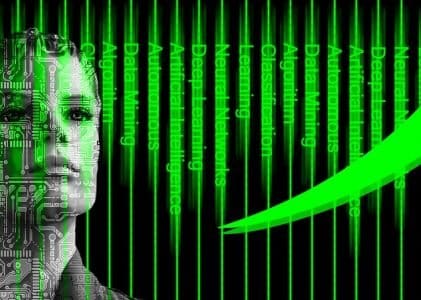 Catherine Solazzo, vice president of developer engagement for IBM Digital Business Group, points out two areas where AI will develop higher education:
Catherine Solazzo, vice president of developer engagement for IBM Digital Business Group, points out two areas where AI will develop higher education:
“To impart learners with skills that will help them succeed in the new world of AI; and for use by administrators to leverage that technology and understand how students learn, to then create a more personalized experience for them.”
Empower Education with Hybrid Learning
The research report: Hybrid Learning in Higher Education: The Potential of Teaching and Learning with Robot-Mediated Communication by Benjamin Gleason, Iowa State University and Christine Greenhow, Michigan State University, shows that robots could form an engaging bridge between online learners as well as with students that are physically present in class. The method is termed blended hybrid learning. Where Michigan State University has taken the lead in the development with a project that started in 2015.
The conclusion of the study mentioned above is that Robot-Mediated Communication “offers advantages over traditionally used videoconferencing, including affordances for fostering students’ embodiment in the classroom, their feelings of belonging and trust, and their ability to contribute ideas in authentic ways.” See the video below for more information.
Empower Education with Robots
A new doctoral thesis from Gothenburg University presents research of pupils’ interaction with an empathic robotic tutor in a middle school class in western part of Sweden. The robot was designed to be able to interact socially. The research conducted by Sofia Serholt focused on the pupil’s interactions with the robot over time and across different educational scenarios. Thesis also explores the ethical dilemmas.
The results show that the pupils follows instructions from the humanoid robot,. At same time as they are able to emotionally relate to it. However, the children have harder to ask the robot for help when they stumble on something they do not understand. The researcher Sofia Serholt comments to gp.se:
“This probably to a large extent depends on how you introduce the robot to the children. In this case, they knew that the robot’s knowledge was limited.”
Serholt concludes about ethical dilemmas. That it has to be dealt with before starting to use humanoid robots on a larger scale in education.
Written by
LarsGoran Bostrom©
Author of the book “Learning Design in Practice for Everybody” and the founder of eLearningworld Europe AB. And also the developer of SOE (Storyteller on eLearningworld) – a new platform for integrated storytelling in interactive books, with integrated gamification and soon with augmented reality features. Read more about our Storyteller for Business services here
Opens in a new tab



